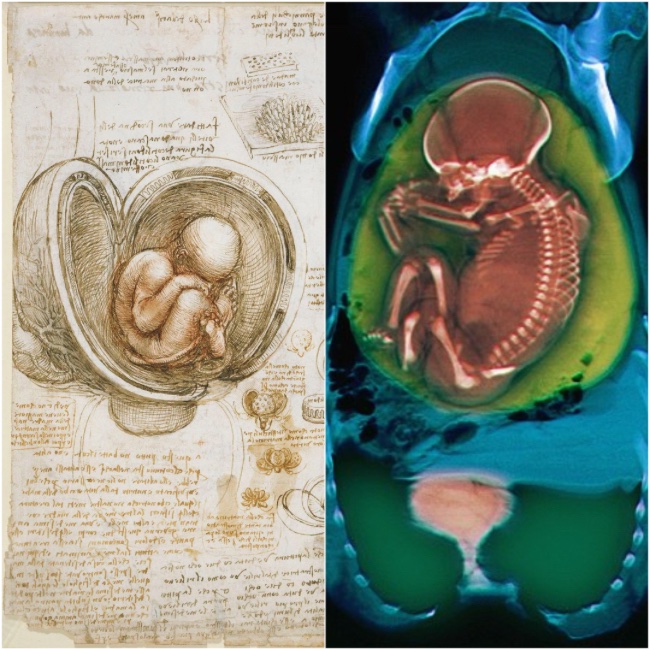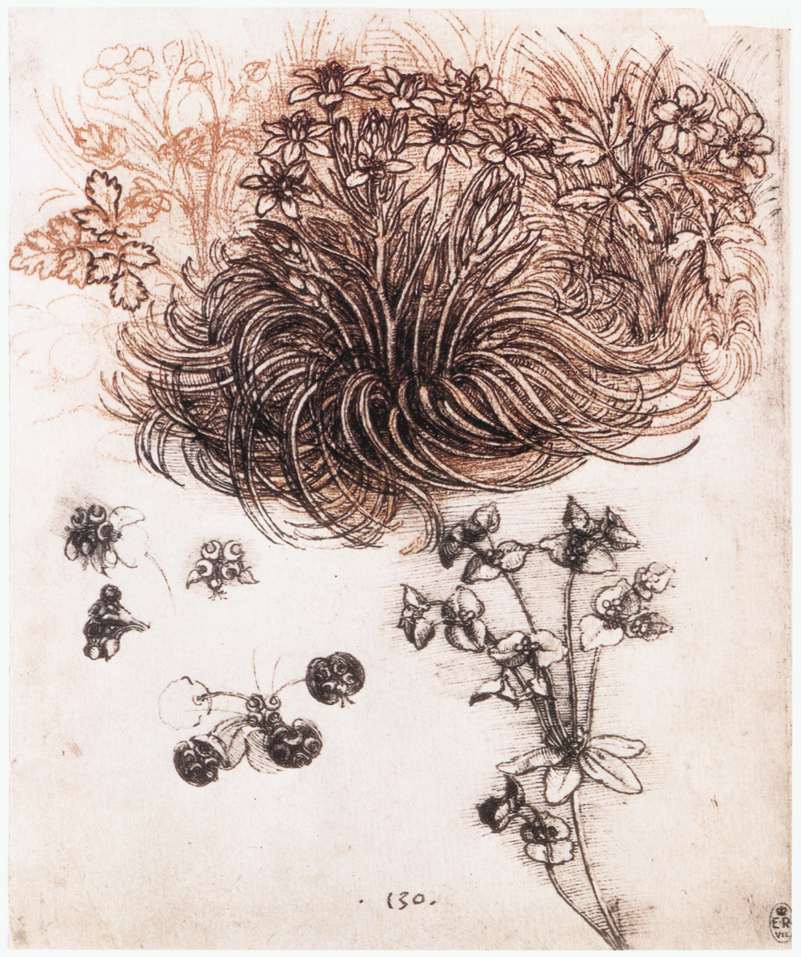The Genius of Leonardo Da Vinci, born 572 years ago on April 15, 1452 - thread 🧵
1. Château de La Rochefoucauld's staircase
1. Château de La Rochefoucauld's staircase

This magnificent spiral staircase was built in the Renaissance style by Anne de La Rochefoucauld in 1520, following Leonardo's designs which were given to her by the King of France. 

2. Leonardo da Vinci embodies the archetypal Homo Universalis, and his "Vitruvian Man," a drawing inspired by the writings of the ancient Roman architect Vitruvius, was described by Carmen C. Bambach as "justly ranked among the all-time iconic images of Western civilization". 

3. The Mona Lisa
The most famous, and perhaps most mysterious, portrait of all time—characterized by its enigmatic expression and atmospheric illusionism—is said to be "the best-known, the most visited, the most written-about and the most parodied work of art in the world."
The most famous, and perhaps most mysterious, portrait of all time—characterized by its enigmatic expression and atmospheric illusionism—is said to be "the best-known, the most visited, the most written-about and the most parodied work of art in the world."

4. The Last Supper
According to many art scholars, this masterpiece marks the onset of the High Renaissance.
Its mastery of space, perspective, motion, and profound depiction of human emotion has solidified its status as one of the most renowned paintings of the Western world.
According to many art scholars, this masterpiece marks the onset of the High Renaissance.
Its mastery of space, perspective, motion, and profound depiction of human emotion has solidified its status as one of the most renowned paintings of the Western world.

"The Pyramid is the name I apply to the lines which, starting from the surface and edges of each object, converge from a distance and meet in a single point." -Leonardo da Vinci 

5. But Leonardo transcended the label of mere artist. He was an astronomer, geologist, mathematician, botanist, engineer, architect, musician, and even an inventor.
For instance, his study of bird flight inspired the designs for the "ornithopter," a pioneering flying machine.
For instance, his study of bird flight inspired the designs for the "ornithopter," a pioneering flying machine.

6. Helicopter
In the late 1480s, he even drew his design for an "aerial screw", a flying object which is incredibly similar to a modern-day helicopter.
Leonardo designed various aerial machines, including an early parachute, the aforementioned ornithopter and a hang glider.
In the late 1480s, he even drew his design for an "aerial screw", a flying object which is incredibly similar to a modern-day helicopter.
Leonardo designed various aerial machines, including an early parachute, the aforementioned ornithopter and a hang glider.

7. Anatomical Studies
Da Vinci is also considered one of the greatest anatomists the world has ever known.
He dissected more than 30 bodies of both genders and all ages during his lifetime, leaving behind many incredibly accurate anatomical drawings.
Da Vinci is also considered one of the greatest anatomists the world has ever known.
He dissected more than 30 bodies of both genders and all ages during his lifetime, leaving behind many incredibly accurate anatomical drawings.

His detailed studies of organs, bones, vessels and muscles have stood the test of time, becoming go-to illustrations in medical textbooks.
Experts argue that "his work remarkably anticipates modern techniques such as MRI scans and 3D computer modeling."
Experts argue that "his work remarkably anticipates modern techniques such as MRI scans and 3D computer modeling."

Comparison: an anatomical drawing of a hand and a modern-day medical scan.
Da Vinci once famously said that "things of the mind left untested by the senses are useless."
Da Vinci once famously said that "things of the mind left untested by the senses are useless."

Leonardo astoundingly depicted the human fetus over 500 years ago, accurately illustrating its position within a dissected uterus.
Comparison: CT scan of a pregnant woman with full term fetus (pictured left) and da Vinci's sketch of a baby inside the womb (pictured right).
Comparison: CT scan of a pregnant woman with full term fetus (pictured left) and da Vinci's sketch of a baby inside the womb (pictured right).

This sketch of the bone structure of the skull has been universally admired for its accuracy and proportion.
"I still use his drawings to teach surgeons and medical students today." -Peter Abrahams, professor of clinical anatomy at Warwick Medical School.
"I still use his drawings to teach surgeons and medical students today." -Peter Abrahams, professor of clinical anatomy at Warwick Medical School.

8. Leonardo also produced extremely precise maps like this one—deemed the "most accurate of its time"—through meticulous manual measurements of every building's angles and distances in the city.
Comparison: da Vinci's map of Imola and the Google Earth photo of the same city.
Comparison: da Vinci's map of Imola and the Google Earth photo of the same city.

9. Perspective - Adoration of the Magi
This unfinished early painting was meant to showcase Leonardo's expertise in composition and perspective.
"The art of perspective is of such a nature as to make what is flat appear in relief and what is in relief flat." -Leonardo da Vinci
This unfinished early painting was meant to showcase Leonardo's expertise in composition and perspective.
"The art of perspective is of such a nature as to make what is flat appear in relief and what is in relief flat." -Leonardo da Vinci

10. Botany
He admittedly found much of his inspiration in nature:
"The painter strives and competes with nature. There is nothing in all nature without its reason, nothing is lacking, and nothing is superfluous. If you know the reason, you do not need the experience."



He admittedly found much of his inspiration in nature:
"The painter strives and competes with nature. There is nothing in all nature without its reason, nothing is lacking, and nothing is superfluous. If you know the reason, you do not need the experience."



Leonardo's botanical studies are evident in the Louvre version of "The Virgin of the Rocks," where each meticulously depicted plant is instantly recognizable to any botanist. 

"As a day well spent makes sleep seem pleasant, so a life well employed makes death pleasant." -Leonardo da Vinci
The Italian polymath died on May 2, 1519, at the age of 67. This is his tomb in the chapel of Saint Hubert at the Château d'Amboise, marked by a plaque indicating it as the presumed site of his remains.
The Italian polymath died on May 2, 1519, at the age of 67. This is his tomb in the chapel of Saint Hubert at the Château d'Amboise, marked by a plaque indicating it as the presumed site of his remains.

But what is the actual defining trait of da Vinci's genius?
Best-selling biographer Walter Isaacson eloquently provides the answer:
"Being curious about everything and curious just for curiosity’s sake, not simply because it’s useful, is the defining trait of Leonardo. It’s how he pushed himself and taught himself to be a genius. We’ll never emulate Einstein’s mathematical ability. But we can all try to learn from, and copy, Leonardo’s curiosity."
Best-selling biographer Walter Isaacson eloquently provides the answer:
"Being curious about everything and curious just for curiosity’s sake, not simply because it’s useful, is the defining trait of Leonardo. It’s how he pushed himself and taught himself to be a genius. We’ll never emulate Einstein’s mathematical ability. But we can all try to learn from, and copy, Leonardo’s curiosity."

Thanks for reading! If you enjoyed this thread, please share the first post and follow me for more content: @JamesLucasIT
https://twitter.com/jameslucasit/status/1779926264180023686
• • •
Missing some Tweet in this thread? You can try to
force a refresh














